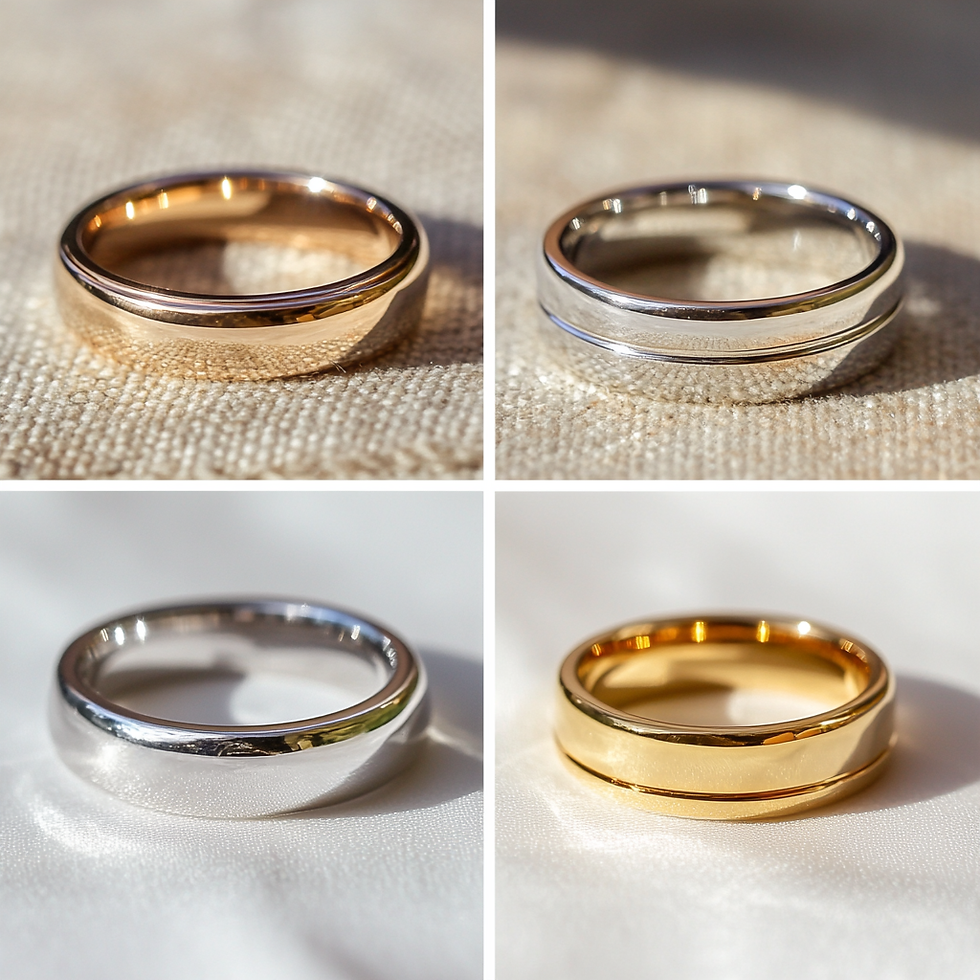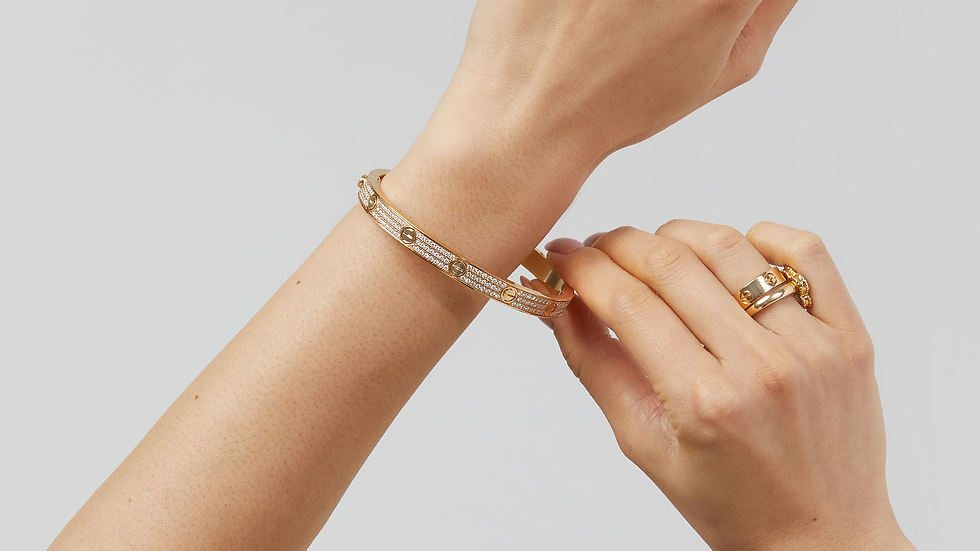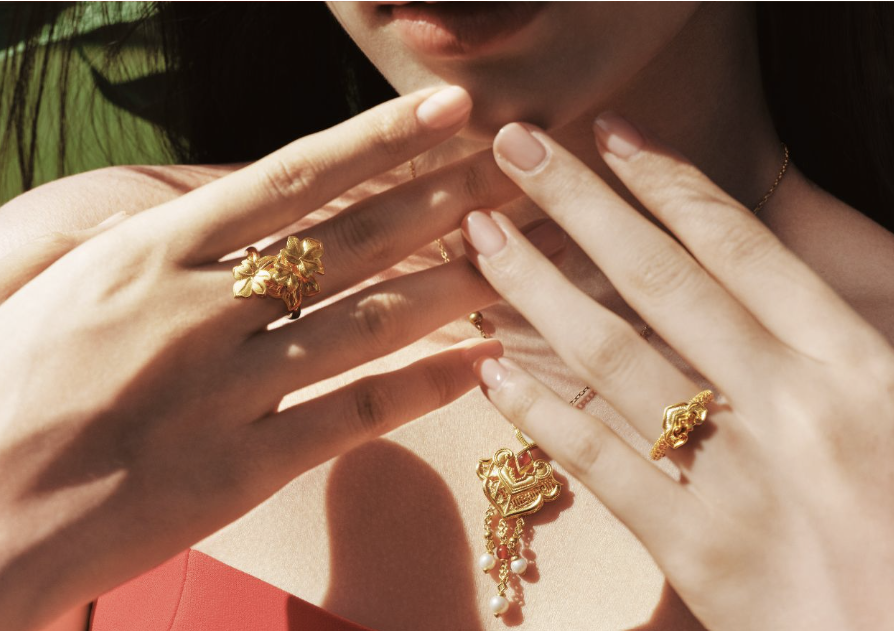A Guide to Luxury Metals in Fine Jewelry: Platinum, 18K Gold, and Silver
- Janet Tam
- May 3
- 5 min read
In the realm of luxury jewelry, the choice of metal profoundly shapes a piece’s aesthetic, durability, cultural resonance, and value. Esteemed maisons such as Cartier, Van Cleef & Arpels, Chaumet, Tiffany & Co., and Harry Winston, alongside prominent Asian jewelers like Chow Tai Fook, Luk Fook, Lao Feng Xiang, TSL Jewellery, Fresh Recollection and Qeelin, meticulously select metals to craft pieces that embody elegance and enduring quality. This guide examines platinum, 18K gold, and silver, comparing their properties and applications while highlighting their use by leading brands and their significance in the Asian market.

Comparative Analysis of Platinum, 18K Gold, and Silver
Value
In luxury jewelry, 18K gold and platinum are the most valuable metals, with platinum typically priced 6% higher per gram due to the specialized craftsmanship required. As a raw material, 18K gold holds greater intrinsic value than platinum. Silver, by contrast, is far less costly, priced at roughly one-tenth the value of gold. However, the labor involved in crafting silver jewelry often surpasses the material cost, making it a labor-intensive yet accessible option.
Density and Durability
18K Gold: Composed of 75% pure gold alloyed with metals like copper and silver, 18K gold balances purity and durability. Unlike 24K gold, which is soft and wears quickly despite its suitability for handcrafting, 18K gold is robust for daily wear, making it the preferred choice for luxury jewelry.
Platinum: The densest precious metal, platinum is approximately 25% denser than 18K gold for the same volume, offering a heavier feel. Its exceptional durability makes it highly resistant to wear, though it develops a subtle, satiny patina over time with prolonged use. This patina, often appreciated for its unique character, can be polished to restore the metal’s original luster if desired. However, buyers who desire a durable polished look should not go for platinum. Platinum’s weight contributes to a slightly higher cost for identical designs, appealing to those who value substantial jewelry.
Silver: The lightest of the trio, silver is prone to oxidation and requires regular repolishing. Though less durable, it remains a cost-effective choice for budget-conscious consumers.
Color
18K Gold: Gold’s versatility shines in its color options— rose, silvery white, or rich yellow—achieved by adjusting alloy compositions. Higher gold content (18K to 24K) produces richer hues, enhancing visual allure.
Platinum and Silver: Both metals are naturally silvery white, with platinum and sterling silver offering a cooler white tone compared to 18K white gold. Their monochromatic palette suits minimalist and classic designs but lacks gold’s color diversity.

Flexibility
Resizing is a key consideration as finger sizes change over time. 18K Gold is the most flexible for resizing, with adjustments costing a few hundred dollars and yielding a polished, seamless finish. Platinum, being harder, is more difficult to resize, often resulting in a small crease line that may concern meticulous wearers. Silver is relatively easy to resize but less prevalent in high-end jewelry due to its lower durability.
Skin Sensitivity
For those with metal allergies, particularly to nickel or brass, high-purity metals are essential. Platinum and 18K Gold, with their high elemental content, are hypoallergenic, ideal for sensitive skin. Silver, while generally safe, may cause reactions if alloyed with less pure metals, requiring careful selection of sterling silver (92.5% pure silver).

Metals in Luxury Jewelry: Brand Perspectives
Cartier
Cartier exemplifies craftsmanship and ethical sourcing, prominently using 18K gold in designs like the Cartier Love Ring. Made of 75% pure gold alloyed with copper and silver, 18K yellow gold offers a warm hue and durability for daily wear. Cartier sources responsibly mined gold from the Eurocantera mine in Honduras, supporting artisanal communities and minimizing environmental impact, reinforcing its commitment to luxurious, enduring pieces.
Van Cleef & Arpels
Van Cleef & Arpels exclusively uses 18K gold across collections like the Alhambra line, with pieces marked “750” to indicate 75% gold content. This metal’s balance of purity and strength supports intricate designs, ensuring lasting brilliance and structural integrity. The maison’s focus on quality makes 18K gold ideal for combining delicate craftsmanship with durability.
Chaumet
With over two centuries of heritage, Chaumet employs 18K gold in yellow, white, and rose varieties to complement its diamonds and gemstones. The metal’s versatility supports techniques like enameling, engraving, and inlay work, aligning with Chaumet’s vision of light and eternity. The durability of 18K gold ensures these intricate creations remain pristine.
Tiffany & Co.
Tiffany & Co. is renowned for its use of platinum in iconic pieces like the Tiffany Setting engagement ring. Platinum’s density, hypoallergenic properties, and subtle patina enhance its appeal, providing a cool, silvery-white backdrop that amplifies diamond brilliance. Its durability ensures Tiffany’s timeless designs endure, appealing to consumers seeking elegance and longevity.
Harry Winston
Harry Winston, celebrated for its exceptional gemstones, frequently uses platinum in high-jewelry collections like the Winston Cluster necklace. Platinum’s strength, neutral tone, and patina development make it ideal for securing vibrant diamonds and colored stones, ensuring both security and aesthetic harmony in intricate designs.
Asian Market Leaders: Chow Tai Fook, Luk Fook, Lao Feng Xiang, TSL Jewellery, Fresh Recollection and Qeelin
In Asian markets, particularly Hong Kong and Mainland China, 18K gold dominates, driven by cultural associations with wealth, prosperity, and good fortune. Chow Tai Fook, a leader in gold purity, offers 18K gold alongside 24K options, favoring the former for its strength and capacity for intricate designs. Luk Fook emphasizes 18K gold’s hardness, ideal for setting diamonds and offering diverse colors and finishes. Lao Feng Xiang, one of China’s oldest jewelers, blends traditional craftsmanship with modern designs, using 18K gold for its durability and cultural appeal. TSL Jewellery, known for innovative designs, prioritizes 18K gold for luxury and practicality. Fresh Recollection, an emerging brand in bespoke jewelry, mainly crafts sculptural 18K gold pieces that resonate with Asian consumers while providing the option for platinum for its Western consumers. Qeelin, a smaller yet influential brand blending Chinese symbolism with contemporary aesthetics, uses 18K gold to create pieces like the Wulu collection, appealing to consumers seeking cultural resonance and modern elegance.

Asian Cultural and Market Alignment
In Asia, 18K gold’s dominance stems from its practical advantages—resistance to tarnish, suitability for daily wear, and ability to hold intricate designs—combined with its cultural significance. Brands like Chow Tai Fook, Luk Fook, Lao Feng Xiang, TSL Jewellery, Fresh Recollection and Qeelin meet these preferences, offering 18K gold pieces that balance luxury with functionality.
The metal’s versatility in color and finish allows these jewelers to cater to diverse tastes while upholding the high standards of fine jewelry.
Conclusion
Platinum, 18K gold, and silver each bring distinct qualities to luxury jewelry, addressing varied preferences in aesthetics, durability, and value. Platinum’s density, hypoallergenic nature, and unique patina make it a premium choice for timeless, substantial pieces, as seen in Tiffany & Co. and Harry Winston’s creations. 18K gold, favored by global and Asian brands, offers versatility, durability, and cultural resonance, making it the cornerstone of fine jewelry. Silver, though less durable, provides an accessible option for elegant designs. By understanding these metals’ properties, consumers can choose pieces that align with their style, practical needs, and cultural values, ensuring lasting beauty and significance.


















Comments